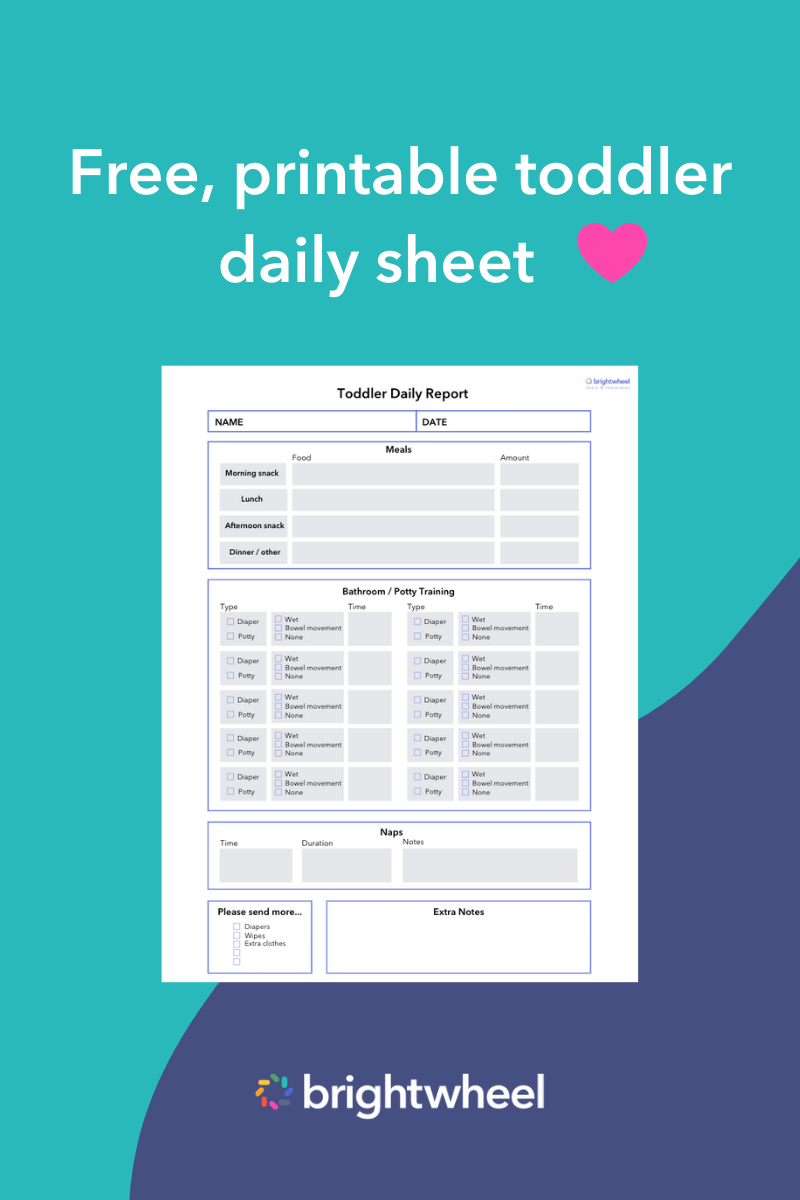
In today's fast-paced world, staying connected with your child's educational and developmental milestones is more important than ever. That's where daycare report cards step in, offering a comprehensive glance into children's progress, behavior, and daily activities.
These report cards are not just sheets of paper; they are a bridge between educators and families, fostering open communication and ensuring that every child's needs are met. In this article, we'll discuss the main areas to include in a daycare report card as well as practical tips and examples to reference as you create your own.
What are the benefits of a daycare report card?
A daycare report card is a form that provides families with an evaluation and update on their child’s developmental progress. Daycare report cards are different from daily reports, which are day-to-day records that track each child’s behavior and improvements through their daily activities.
Daily reports allow teachers and families to monitor learning and conduct changes in real time, and they play a significant role in determining the overall progress of the child, which is later tracked in the daycare report card. Daycare report cards typically contain feedback about a child’s progress over a long period of time, such as a month or a quarter, rather than providing daily feedback. They are often written after large instructional units, so educators can show families their child’s progress, from the beginning of the unit to the end.
With brightwheel progress reports, you can easily create individualized progress reports for each child with photos and videos. You can use custom templates to save time and maintain consistency across your program and instantly share with families.
The benefits of daycare report cards include:
- Improving teacher instruction
- Identifying learning and behavior trends
- Encouraging collaboration between teachers and families
- Identifying at-risk children or children with developmental delays
- Increasing accountability and transparency in a child’s learning instruction
A child’s education is not a matter only left to teachers and administrators. Writing daycare report cards is the best way to keep all parties—teachers, families, and administrators—aware of each child’s progress and actively working towards their success.
What areas do I cover in my daycare report card?
When evaluating the children at your daycare or childcare center, it is fundamental to monitor skills that will help them develop into well-rounded individuals and successful students.
These skills include:
- Social-emotional
- Language
- Cognitive
- Physical
Social-emotional
Social-emotional skills are foundational to relating to others and building healthy relationships. As an educator, you are assessing the children's capacity and progress towards self-awareness, self-regulation, and their ability to collaborate and resolve conflicts.
Language
Language and literacy development is central to a child’s ability to effectively communicate. Assessment of language differences or delays can indicate developmental concerns. To fully evaluate a child, assess both their receptive and expressive language skills.
Cognitive
When assessing cognitive skills, you might test a child’s verbal comprehension, memory, perceptual reasoning, and processing speed. This allows you to identify cognitive strengths and weaknesses, specifically whether a child is intellectually gifted or experiencing any learning disabilities.
Physical
Although physical development assessments for children are often conducted by pediatricians, as a teacher, you are also responsible for monitoring their physical progression. Most daycare-aged children have mastered gross motor skills such as crawling, standing, walking, reaching, pulling, lifting, and balancing. These skills are crucial in a child’s growing independence needed for tasks such as using the bathroom or getting dressed.
How to assess each area
Assessments are an integral part of the learning process for children. They allow educators to gather information on a child and use it to plan curriculum or educational activities at a level which the child understands.
At this age, a child’s skill and performance isn’t usually graded with the classic academic grading scale of A+ to F that most are used to. Instead, they are typically assessed using terms that demonstrate the progress of the skills you’re evaluating them on. For example, skills can be evaluated as "P - present", "E - emerging", or "N - not yet emerging". Using an assessment system similar to this will allow you to notify parents of their child’s strengths and opportunities for growth in a neutral, productive way.
There are multiple informal and formal assessment methods that you, as a teacher, can use with your children. Informal assessment methods include observations, one-on-one conversations, and samples of children's work. These are usually non-intrusive to the children while allowing you to observe and collect information on the progress of their development. They are also often considered formative assessment, meaning they evaluate a child's understanding during the learning process. Educators are given real-time feedback on a child's progress and can address any issues as they come up. In contrast, a more formal or summative assessment usually happens at the end of a lesson and measures cumulative learning.
Formal assessments are another method used to assess children's development and include things like standardized tests, progress report cards, and portfolios. This method is typically standardized and performance is evaluated against a standard or benchmark. The results of a formal assessment can support teachers and families to determine the best ways to support a child’s development or make a plan for next steps such as following up with a developmental specialist.
Although different in form, both informal and formal assessment methods have the same purpose. They allow you to learn the developmental strengths and areas for growth of your children and build your curriculum to promote their learning.
How often do you give progress report cards?
While the exact frequency will vary depending on your center’s program, it is a good idea to schedule your daycare report cards around a series of lesson plans.
When you present parents with their child’s report card, you want to ensure that it shows a child’s clear progress from one point to another.
If you schedule your daycare report cards around your lesson plans, administrators and teachers can easily evaluate how a child progressed during that period of time.
Tips on writing daycare progress report cards
Before you get started on your daycare progress reports, we’d like to share a few tips to keep in mind as you complete your evaluations.
Be specific
When writing progress report cards, be sure to include specific examples of how a child is progressing towards their developmental goals.
Refer to each child’s daily records for evidence of clear instances of any improvements or changes in learning. Consult other teachers who know the child to get additional feedback or insights about a child’s progress. Including specific examples will reduce any confusion and help families understand your assessment.
Start working on the reports early
Don’t wait until the last minute to start your daycare progress reports. Make sure you give yourself the time to accurately review each child’s development.
As previously mentioned, using specific examples is key to helping families understand your evaluation. It may take time to sift through weeks' or months' worth of daily records, so give yourself ample time.
Use technology
Taking photos and videos of a child’s progress can add context to your observations. For example, if you are teaching the children to draw and trace lines and you want to document a child’s improvement, you may want to take a picture of a child’s linework and compare it to a picture of their work from the beginning of the unit.
You can use software like brightwheel to create an anecdotal record of the child’s progress based on your photos and observations. Keeping anecdotal records can make it easier to track the children’s progress in each developmental domain so you can construct thorough progress report cards.
Document any areas of concern
If you notice that a child has areas of concern, these must be documented and shared with families.
Areas of concern might include self-regulation or attention to task; however, if the situation is serious or time sensitive, such as challenging behaviors that may harm other children, notify parents immediately and communicate the entirety of the information in a meeting.
Generally, make parents aware of any developmental concerns as they arise, so there are no surprises when you deliver your progress report card.
Include personal touches
Parents like to know that you’ve developed a genuine connection with their child. To properly demonstrate that, include something personal about each child in your progress report card.
You might include a positive anecdote or discuss a talent or personality trait you’ve noticed. This demonstrates that you see their child as an individual versus one of many in the class.
Finish on a positive note
Conclude your progress reports with a section for goals and any next steps. Create goals with input from families and consider any important developmental milestones.
This section can also be used as an opportunity to celebrate those achievements, big and small, that have occurred since the last progress report.
Daycare report card templates
As a teacher, the format you use for your daycare report card is up to you; however, you might find it useful to use a template as a reference.
The following templates are great tools to guide you as you create your own:
The above template is easy to follow and provides a comprehensive look into a child’s progress through the identification of their cognitive, social-emotional, and language skills.
The above is another great template that allows you to break down a child’s behavior into social and emotional skills and work habits. The evaluation timeline used is an effective demonstration of how a child’s progress can be monitored throughout the year.
Better report cards are on the way
Follow the steps and tips in this article to create an effective daycare report card and evaluate your children like a seasoned professional.
As you take the time to get to know your children, assess their skills, and fill out their progress report cards, you’re creating the space for a positive learning experience for the child and cohesive collaboration between the teacher, families, and administrators.
Brightwheel is the complete solution for early education providers, enabling you to streamline your center’s operations and build a stand-out reputation. Brightwheel connects the most critical aspects of running your center—including sign in and out, parent communications, tuition billing, and licensing and compliance—in one easy-to-use tool, along with providing best-in-class customer support and coaching. Brightwheel is trusted by thousands of early education centers and millions of parents. Learn more at mybrightwheel.com.


